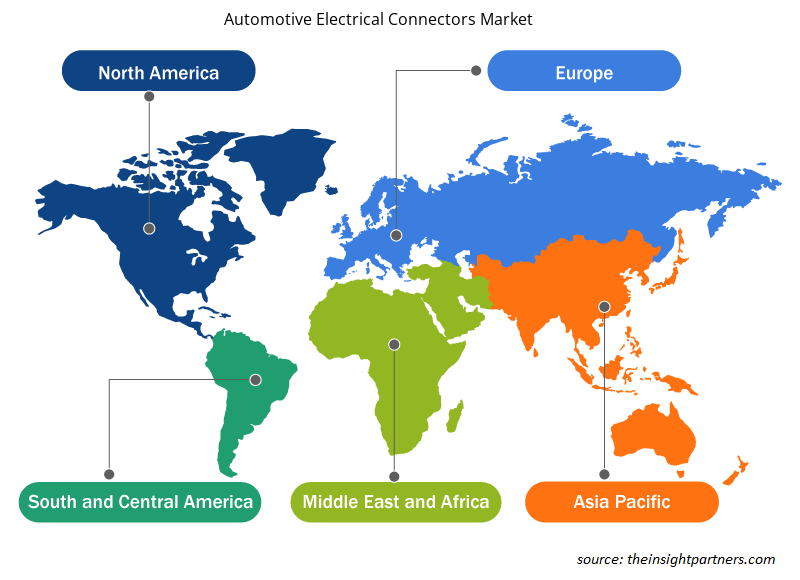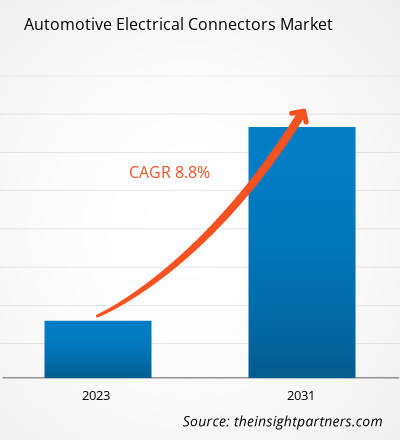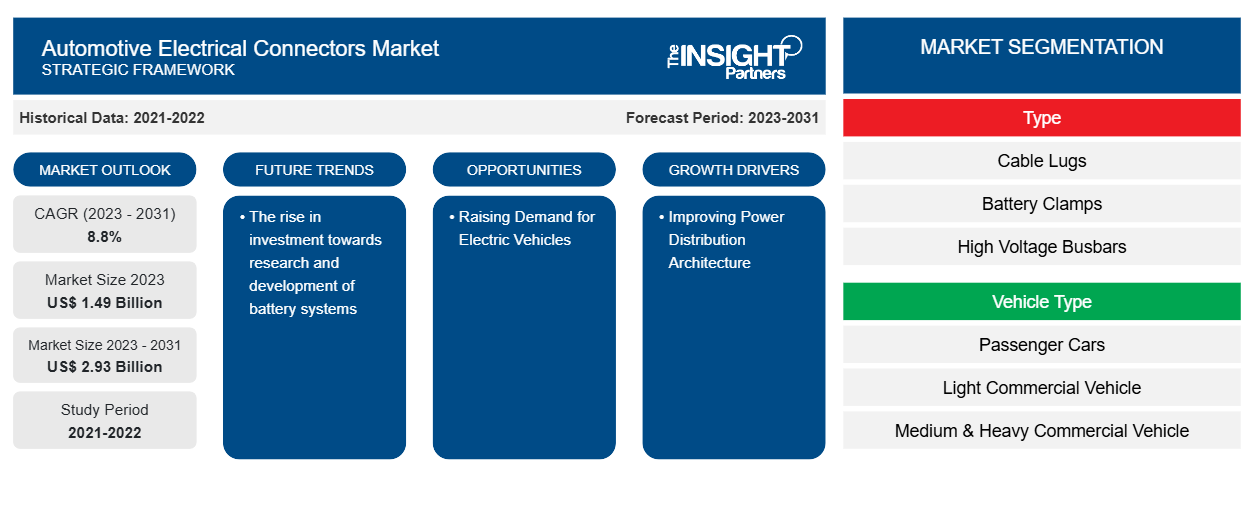Se prevé que el tamaño del mercado de conectores eléctricos para automóviles alcance los 2.930 millones de dólares en 2031, frente a los 1.490 millones de dólares en 2023. Se prevé que el mercado crezca a una tasa compuesta anual del 8,8 % durante el período 2023-2031. Es probable que el aumento de la inversión en investigación y desarrollo de sistemas de baterías siga siendo una tendencia clave en el mercado.
Análisis del mercado de conectores eléctricos para automoción
Se espera que el aumento de la electrificación de la infraestructura de transporte y de los vehículos en todo el mundo impulse la demanda de conectores eléctricos para automóviles, lo que a su vez impulsará el crecimiento del mercado en los próximos años. Además, se prevé que la mejora de la arquitectura de distribución de energía impulse el crecimiento del mercado de conectores eléctricos para automóviles durante el período de pronóstico. Además, se prevé que el aumento de la demanda de vehículos eléctricos y vehículos eléctricos híbridos cree oportunidades para las empresas clave que operan en el mercado entre 2023 y 2031.
Descripción general del mercado de conectores eléctricos para automóviles
El ecosistema del mercado de conectores eléctricos para automóviles comprende las siguientes partes interesadas: proveedores de materias primas, fabricantes de conectores, OEM y usuarios finales. Los proveedores de materias primas suministran el material para construir los conectores eléctricos para automóviles, como cobre, níquel y plata. Además, los componentes pequeños van desde un pequeño tornillo hasta una caja de cierre. Los fabricantes de conectores llevan a cabo varios procesos, como diseño, ensamblaje y producción, para transformar las materias primas en productos terminados. INTERCABLE srl, Amphenol Corporation y Rogers Corporation, entre otros, son fabricantes líderes de conectores eléctricos para automóviles.
Las empresas ofrecen diversos tipos de productos, como terminales de cables, barras colectoras de alto voltaje, abrazaderas de batería y cajas de fusibles a fabricantes de vehículos y clientes del mercado de accesorios. Estos conectores eléctricos son adquiridos por fabricantes de equipos originales como Volkswagen, Toyota, Volvo, Daimler y Ford Motor Company. Los usuarios finales tienen una gran cantidad de clientes, desde compradores de vehículos de uso personal hasta operadores de flotas. Las empresas de fabricación de conectores eléctricos para automóviles también brindan servicio posventa a los clientes para reemplazar los conectores del vehículo.
Personalice este informe según sus necesidades
Obtendrá personalización en cualquier informe, sin cargo, incluidas partes de este informe o análisis a nivel de país, paquete de datos de Excel, así como también grandes ofertas y descuentos para empresas emergentes y universidades.
- Obtenga las principales tendencias clave del mercado de este informe.Esta muestra GRATUITA incluirá análisis de datos, desde tendencias del mercado hasta estimaciones y pronósticos.
Impulsores y oportunidades del mercado de conectores eléctricos para automoción
Mejorar la arquitectura de distribución de energía para favorecer el mercado
Los países desarrollados, como Estados Unidos, el Reino Unido y Alemania, están adoptando firmemente el uso de vehículos eléctricos. Las empresas que operan en la región desarrollada están desarrollando tecnologías de baterías de alto voltaje para mejorar la potencia del vehículo y la capacidad de almacenamiento de energía. Por lo tanto, la demanda de conectores de soporte para proporcionar conexiones eléctricas eficientes está creciendo, lo que impulsa el crecimiento del mercado. Se están desarrollando nuevos productos eléctricos, como cajas de fusibles, terminales de cables y barras colectoras, para mejorar la distribución de energía. Las cajas de fusibles son necesarias para mantener una distribución de energía eficiente, lo que está impulsando la demanda de cajas de fusibles, impulsando así el mercado.
Por ejemplo, en abril de 2021, Eaton, el segmento de negocio de movilidad eléctrica, recibió un contrato para desarrollar fusibles de la serie Bussmann y unidades de distribución de energía (PDU) para fabricantes de vehículos. Las PDU, también conocidas como cajas de fusibles, se utilizarán para un nuevo vehículo eléctrico de batería (BEV) para aplicaciones comerciales ligeras. Las cajas de fusibles transmiten la energía de la batería a los componentes del vehículo con una función de seguridad al brindar protección al circuito. La cambiante arquitectura de distribución de energía está creando la demanda de nuevas cajas de fusibles, lo que impulsa el crecimiento del mercado.
Creciente demanda de vehículos eléctricos
Los gobiernos de diferentes países emiten regulaciones específicas para controlar las emisiones de los vehículos diésel y de gasolina. Por lo tanto, debido a esta norma, los fabricantes de vehículos están cambiando su enfoque hacia la producción de vehículos híbridos enchufables, vehículos híbridos y vehículos eléctricos de batería. Las emisiones de los vehículos son la principal fuente de contaminación en todo el mundo, y los vehículos como los automóviles, camiones y autobuses son los mayores contribuyentes en esta categoría. La alta eficiencia de los vehículos eléctricos (VE) en comparación con los vehículos tradicionales diésel y de gas natural es uno de los factores clave que se prevé que impulsen el mercado de conectores eléctricos para automóviles durante el período analizado. Además, los gobiernos de varios países como EE. UU., Reino Unido y Alemania ofrecen programas de subsidios para promover la utilización de vehículos eléctricos. Por lo tanto, se espera que el aumento de la demanda de vehículos eléctricos cree oportunidades para las empresas clave en el mercado de conectores eléctricos para automóviles de 2023 a 2031.
Análisis de segmentación del informe de mercado de conectores eléctricos automotrices
Los segmentos clave que contribuyeron a la derivación del análisis del mercado de conectores eléctricos automotrices son el tipo, el tipo de vehículo y el tipo de tren motriz.
- Según el tipo, el mercado de conectores eléctricos para automóviles se divide en terminales de cable, abrazaderas de batería, barras colectoras de alto voltaje y cajas de fusibles. El segmento de cajas de fusibles tuvo la mayor participación de mercado en 2023.
- Por tipo de vehículo, el mercado está segmentado en turismos, vehículos comerciales ligeros (LCV) y vehículos comerciales medianos y pesados (M&HCV). El segmento de turismos tuvo la mayor participación del mercado en 2023.
- Por tipo de motor, el mercado se divide en motor de combustión interna (ICE), vehículo eléctrico (EV), vehículo eléctrico híbrido enchufable (PHEV) y vehículo eléctrico híbrido (HEV). El segmento de motor de combustión interna tuvo una participación significativa del mercado en 2023.
Análisis de la cuota de mercado de conectores eléctricos para automóviles por geografía
El alcance geográfico del informe de mercado de conectores eléctricos automotrices se divide principalmente en cinco regiones: América del Norte, Asia Pacífico, Europa, Medio Oriente y África, y América del Sur y Central.
El alcance del informe de mercado de conectores eléctricos automotrices abarca América del Norte (EE. UU., Canadá y México), Europa (España, Reino Unido, Alemania, Francia, Italia y el resto de Europa), Asia Pacífico (Corea del Sur, China, India, Japón, Australia y el resto de Asia Pacífico), Oriente Medio y África (Sudáfrica, Arabia Saudita, Emiratos Árabes Unidos y el resto de Oriente Medio y África) y América del Sur (Brasil, Argentina y el resto de América del Sur). En términos de ingresos, Asia Pacífico dominó la participación de mercado de conectores eléctricos automotrices en 2023. Europa es el segundo mayor contribuyente al mercado mundial de conectores eléctricos automotrices, seguida de América del Norte.
Perspectivas regionales del mercado de conectores eléctricos para automóviles
Los analistas de Insight Partners explicaron en detalle las tendencias y los factores regionales que influyen en el mercado de conectores eléctricos automotrices durante el período de pronóstico. Esta sección también analiza los segmentos y la geografía del mercado de conectores eléctricos automotrices en América del Norte, Europa, Asia Pacífico, Medio Oriente y África, y América del Sur y Central.

- Obtenga datos regionales específicos para el mercado de conectores eléctricos automotrices
Alcance del informe de mercado de conectores eléctricos automotrices
| Atributo del informe | Detalles |
|---|---|
| Tamaño del mercado en 2023 | 1.490 millones de dólares estadounidenses |
| Tamaño del mercado en 2031 | US$ 2.93 mil millones |
| CAGR global (2023 - 2031) | 8,8% |
| Datos históricos | 2021-2022 |
| Período de pronóstico | 2023-2031 |
| Segmentos cubiertos | Por tipo
|
| Regiones y países cubiertos | América del norte
|
| Líderes del mercado y perfiles de empresas clave |
|
Densidad de actores del mercado de conectores eléctricos automotrices: comprensión de su impacto en la dinámica empresarial
El mercado de conectores eléctricos para automóviles está creciendo rápidamente, impulsado por la creciente demanda de los usuarios finales debido a factores como la evolución de las preferencias de los consumidores, los avances tecnológicos y una mayor conciencia de los beneficios del producto. A medida que aumenta la demanda, las empresas amplían sus ofertas, innovan para satisfacer las necesidades de los consumidores y aprovechan las tendencias emergentes, lo que impulsa aún más el crecimiento del mercado.
La densidad de actores del mercado se refiere a la distribución de las empresas o firmas que operan dentro de un mercado o industria en particular. Indica cuántos competidores (actores del mercado) están presentes en un espacio de mercado determinado en relación con su tamaño o valor total de mercado.
Las principales empresas que operan en el mercado de conectores eléctricos automotrices son:
- INTERCABLE Srl
- Fabricación Connor
- Corporación Amphenol
- Compañía Eléctrica Emerson
- Corporación Rogers
- Molex
Descargo de responsabilidad : Las empresas enumeradas anteriormente no están clasificadas en ningún orden particular.

- Obtenga una descripción general de los principales actores clave del mercado de conectores eléctricos automotrices
Noticias y desarrollos recientes del mercado de conectores eléctricos para automóviles
El mercado de conectores eléctricos para automóviles se evalúa mediante la recopilación de datos cualitativos y cuantitativos a partir de una investigación primaria y secundaria, que incluye importantes publicaciones corporativas, datos de asociaciones y bases de datos. A continuación, se enumeran algunos de los avances en el mercado de conectores eléctricos para automóviles:
- ENNOVI (empresa de electrificación de la movilidad) presentó la solución de conector Ethernet automotriz ENNOVI-Net con interconexiones a presión. Este lanzamiento de producto ha mejorado la cartera de productos de la empresa en este mercado. (Fuente: ENNOVI, comunicado de prensa, marzo de 2024)
- ETCO presentó conectores para vehículos eléctricos. Este nuevo conector puede resistir altas vibraciones, golpes y temperaturas extremas. Estos conectores se utilizan entre los paquetes de baterías y los sistemas de gestión de baterías. (Fuente: ETCO, comunicado de prensa, mayo de 2022)
Cobertura y resultados del informe de mercado de conectores eléctricos automotrices
El informe “Tamaño y pronóstico del mercado de conectores eléctricos automotrices (2021-2031)” proporciona un análisis detallado del mercado que cubre las siguientes áreas:
- Tamaño del mercado de conectores eléctricos automotrices y pronóstico a nivel global, regional y nacional para todos los segmentos clave del mercado cubiertos bajo el alcance
- Tendencias del mercado de conectores eléctricos automotrices, así como dinámica del mercado, como impulsores, restricciones y oportunidades clave
- Análisis PEST y FODA detallados
- Análisis del mercado de conectores eléctricos automotrices que cubre las tendencias clave del mercado, el marco global y regional, los principales actores, las regulaciones y los desarrollos recientes del mercado
- Análisis del panorama de la industria y de la competencia que abarca la concentración del mercado, el análisis de mapas de calor, los actores destacados y los desarrollos recientes del mercado de conectores eléctricos automotrices
- Perfiles detallados de empresas
- Análisis histórico (2 años), año base, pronóstico (7 años) con CAGR
- Análisis PEST y FODA
- Tamaño del mercado, valor/volumen: global, regional y nacional
- Industria y panorama competitivo
- Conjunto de datos de Excel
Informes recientes
Testimonios
Razón para comprar
- Toma de decisiones informada
- Comprensión de la dinámica del mercado
- Análisis competitivo
- Información sobre clientes
- Pronósticos del mercado
- Mitigación de riesgos
- Planificación estratégica
- Justificación de la inversión
- Identificación de mercados emergentes
- Mejora de las estrategias de marketing
- Impulso de la eficiencia operativa
- Alineación con las tendencias regulatorias























 Obtenga una muestra gratuita para - Mercado de conectores eléctricos automotrices
Obtenga una muestra gratuita para - Mercado de conectores eléctricos automotrices